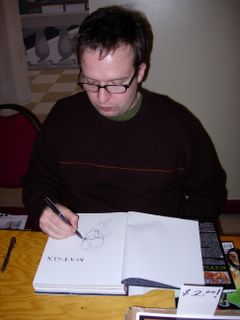
Artist Steve Skroce (The Amazing Spider-Man, The Matrix storyboards, Doc Frankenstein) at the Vancouver Comicon
Several weeks prior, I decided to indulge in the ultimate geek gathering, the Comic Book Convention. Harkening images of sweaty young to middle aged males that don't get enough exercise, debating as to who would win in a fight between Namor the Sub-Mariner and Aquaman, and the endless line-ups of people who want autographed comics, I went anways.
Things have certainly changed in the past twelve years.
The first comic book convention I ever went to was back in 1993, when Canadian alternative press artist Dave Sim (Cerebus) was doing signings at the Heritage Hall. I remember reading the comics years previous. While the serialized adventures of a talking aadrvark never got mainstream attention along the level of X-Men or Batman, the book enjoyed a fairly lengthy run (300 issues) and even managed to have some cross-over appeal, with his character making guest appearances in issues if Teenage Mutant Ninja Turtles and Spawn.
It was the guest appearance in Spawn #10 that attracted all the fans, as the line-up to get his autographs and sketches was looooooong. This was all for a book that would almost never crack the top 100 selling comic books on a month-to-month basis.
Flash forward to 2005, where Vancouver-based artist Steve Skroce is doing signings. I go in and there is no lineup whatsoever. Remembering to bring my copy of The Art of the Matrix and my entire collection of Gambit comic books, I walk up to Mr. Skroce's booth, where he isn't doing much. Not really sure of who he is (I saw a photo of him published in an issue of Wizard, but that was years ago), I introduce myself and we chat. I get him to do a sketch of Trinity inside the Matrix art book, and then he signs all my comics, thanking me for buying all of those books.
The fact that a mainstream artist that has worked on many high profile projects is not nearly as a big a draw as an independent small-press comic book artist and writer tells me that the comic book industry is not nearly as profitable as it once was.
Ideas on how to save the comic book industry have been proposed by the handful. Put comic books in more locations apart from comic book specialty shops. More diversity in genres apart from superheroes. Make the books cheaper. Make them more accessible to younger readers.
Archie and Betty and Veronica repeatedly tell the same stories over and over again, with very few changes in the status quo, yet their circulation numbers are in the millions. In Japan, manga titles are accessible to audiences of all age groups and demographics, while you can get the latest issue of whatever hot title from a local vending machine. The top selling mainstream comic book, The Astonishing X-Men, moves less than 100,000 copies per month, despite the fact that Marvel Comics owns 37% of the market share, while Archie has a 0.38% market share.
Compare this to 1991, where X-Men #1 moves 8 million copies.
Whatever the industry needs to do to right itself, it must be done fast, as comic book stores are becoming an increasing rarity, as are comic book publishers (Dreamwave Productions, the Toronto based studio that produced the TransFormers comics, is the most recent casualty). At this rate, it will only be a matter of time until the heroes of the four colour world will only be seen in a theatre near you. And if the recent spate of comic book films is any indication (ie: Elektra, Catwoman), it won't be long until it's only seen at the video store.
Sunday, February 06, 2005
Subscribe to:
Post Comments (Atom)

No comments:
Post a Comment